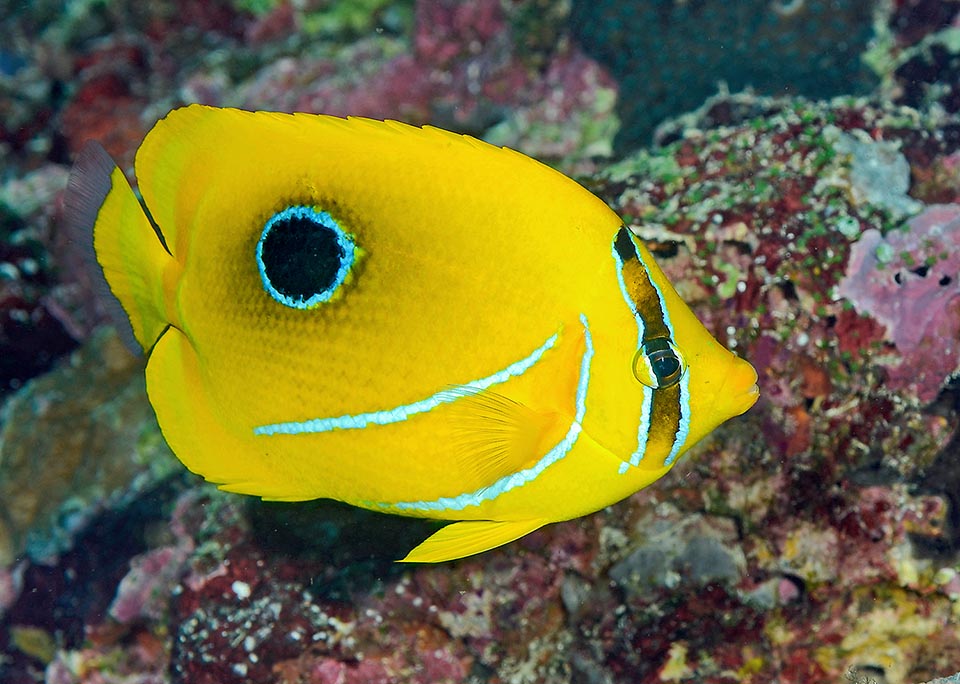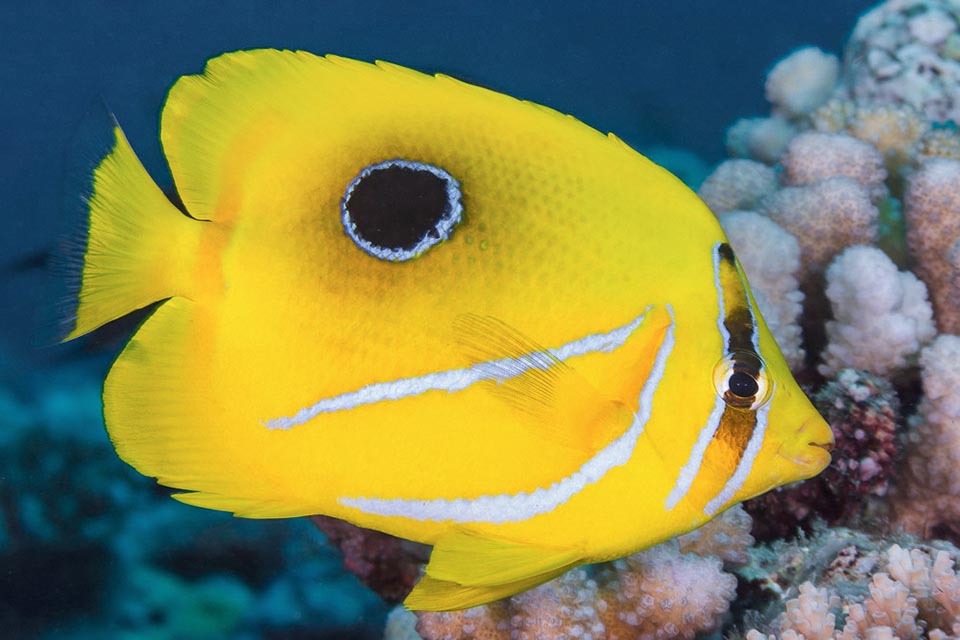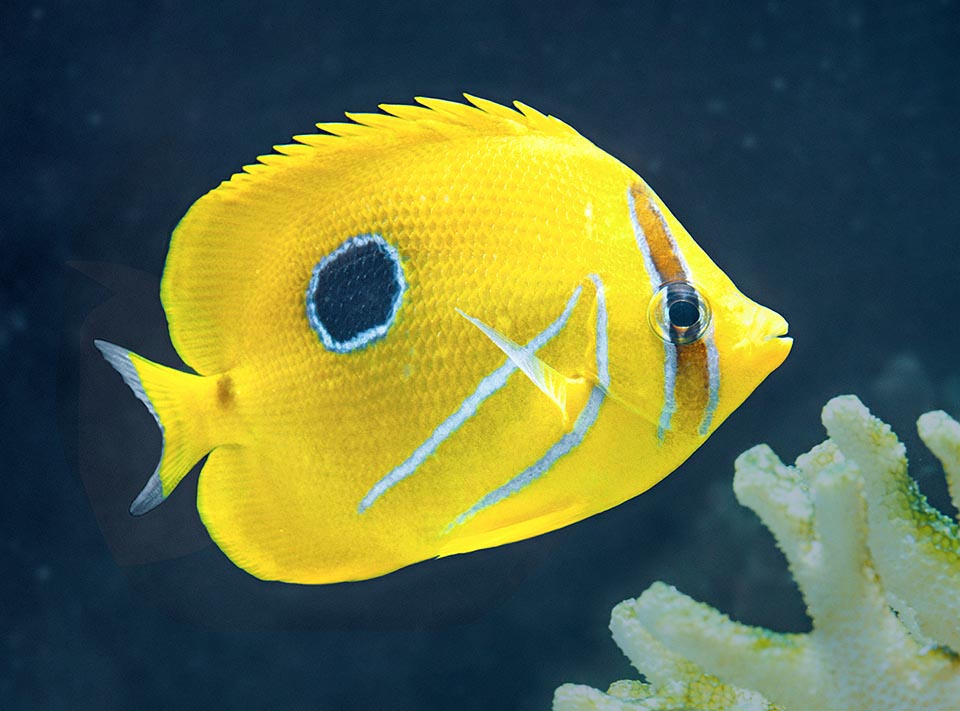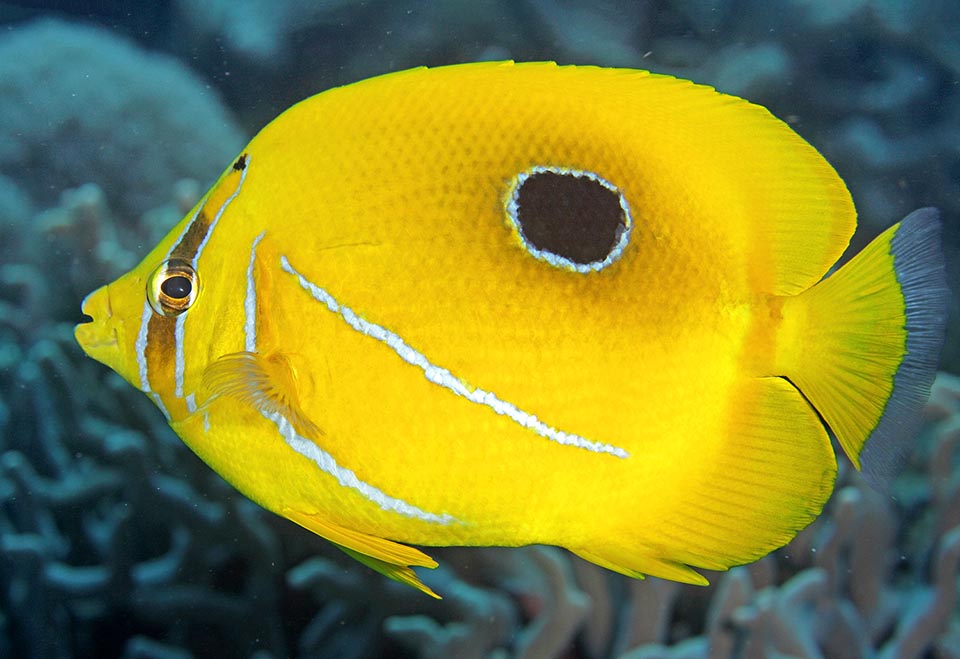Family : Chaetodontidae

Text © Giuseppe Mazza

English translation by Mario Beltramini

The Eclipse butterflyfish (Chaetodon bennetti) gets the vulgar name from the characteristic black spot edged with blue placed in the second half of body © Benoit Lallement
Rare in the aquariums the Bluelashed butterflyfish or Eclipse butterflyfish (Chaetodon bennetti Cuvier, 1831), belongs to the class of the Actinopterygii, the ray-finned fishes, to the order of Perciformes and to the colourful family of Chaetodontidae.
The name of the genus Chaetodon comes from the Greek “χαίτη” (khaite) = hair and “ὀδούς” (odous) = tooth, due to the “bristle-shaped teeth”.
The name of the species bennetti honours the memory of the British physician and zoologist Edward Turner Bennett (1797-1736) who did show this species to Cuvier at the British Museum of London.
Zoogeography
It has a very vast distribution, but with few members, in the tropical waters of the Indo-Pacific. We find it from South Africa and Madagascar up to India, Sri Lanka and Australia, and then in Indonesia, New Guinea, Micronesia, New Caledonia, Philippines and Taiwan up to south of Japan. Eastwards, it reaches the Fiji and Tonga islands, and southwards, Lord Howe Island and Easter Island.

At most 20 cm long, it has a very vast distribution in the tropical Indo-Pacific, but it is not easy to observe because their numbers are scarce © François Libert
Ecology-Habitat
It lives in the madreporic formations, between 1 and 30 m of depth.
Morpho-physiology
The body is flat like all the butterflyfishes, more or less oval with the snout fairly short, and can reach the 20 cm of length. The dorsal fin has 13-14 spiny rays and 15-17 soft; the anal has 3 spiny rays and 14-16 soft. The ventral and pectoral fins are unarmed. The caudal is more or less blunt.
It is immediately recognized due to its splendid yellow livery, on which stands out, upward, in the second half of the body, a circular black spot edged of light blue which recalls a solar eclipse.

Its only defense, besides the fake eye that in the dark may appear as that of a big fish, are the spines of the dorsal fin it often raises to seem bigger © Giuseppe Mazza
On the sides we note also two light blue traits: one which folds under the pectoral in direction of the anal fin and the other, oblique, in a rearmost position. The eye is camouflaged, as usual, by a vertical band, in this case brown with light blue edge.
Ethology-Reproductive Biology
The bluelashed butterflyfish nourishes almost exclusively of coral polyps and when that happens, of small invertebrates. For some, it should eat also some seaweed, but this is not confirmed, as it is a fairly rare species and therefore little studied.
Usually, the adults live paired and reproduce with pelagic eggs. The juveniles are quite similar to the parents, but the light blue patterns are initially white.

The snout is short as it does not look for food in the holes, as it mainly eats the corals’ polyps. It does not seem an endangered species but the data to say this are missing © Klaus Stiefel
Seen that the Chaetodon bennetti does not have any alimentary interest and is not required by the aquaria lovers, because when in captivity it does not find the suitable food, we might conclude that, in spite of the global warming and the reefs destruction, it is not an endangered species, because the individuals to nourish are, after all, a few with an enormous distribution.
The populations may double in less than 15 months and nowadays the fishing vulnerability index is very low, of 10 on a scale of 100, but as the experts of Red List say, it is “Data deficient”, which means that they do not have enough elements for evaluating the situation.
Synonyms
Chaetodon vinctus Lay & Bennett, 1839.
→ For general information about FISH please click here.
→ For general information about BONY FISH please click here
→ For general information about CARTILAGINOUS FISH please click here.
→ To appreciate the BIODIVERSITY of BONY FISH please click here.
→ To appreciate the BIODIVERSITY of CARTILAGINOUS FISH please click here.
